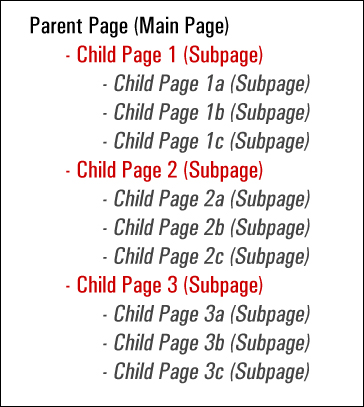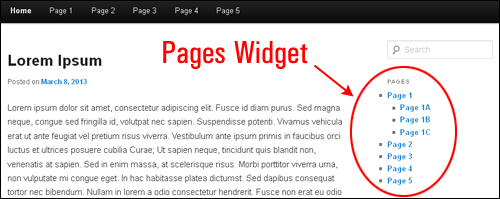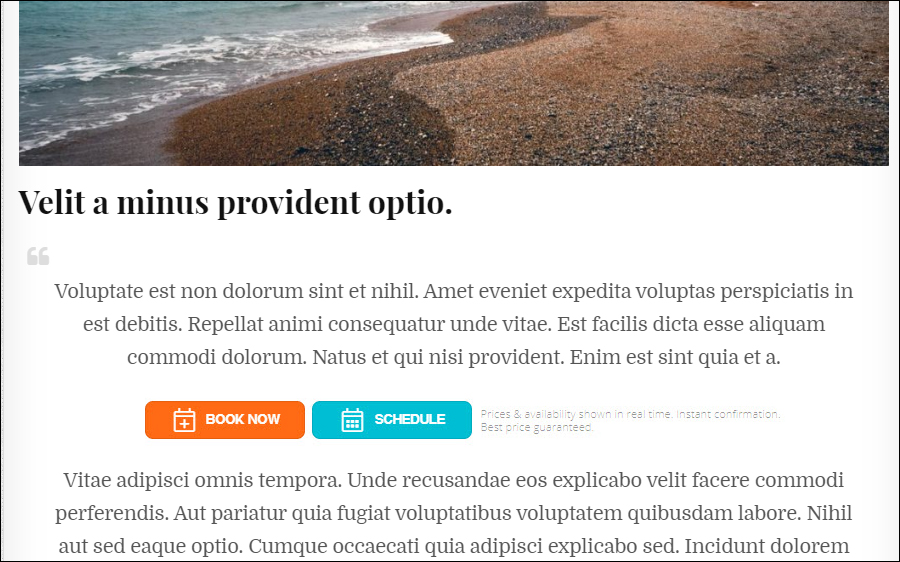WordPress Posts Vs. WordPress Pages Explained

WordPress lets you publish information on your website using two main content types: Posts and Pages.
You can publish content online using either a Post or a Page. Also, adding content to your Posts and Pages and then managing these use almost identical features of the WordPress Content Management System (CMS).
So, if you can use either of these content types and manage these using almost the same features, what makes them different and when do you know which type to use?
This is the focus of this tutorial.
WordPress Posts vs WordPress Pages
While your readers may not care whether you publish content on your site using a Post or a Page, it’s important that you:
a) understand the main differences between the two content types, and
b) know when to use these.
Let’s start with Posts.
Posts
Most people associate blogs with content related to personal opinions, online journals or diaries, lists of tips or advice, product reviews and recommendations, news and updates, special announcements, etc.
Typically, blog entries are published using posts (i.e. a “blog post”).
Some unique features of posts include the following:
- Post publish date. Unless there’s been some customization or modification to your site, post entries typically display their publishing date and appear in reverse chronological order on your blog page (i.e. your most recently published entries show above your older posts).
- Post SEO. Posts can include various features and settings to help search engines index your content more easily. Also, WordPress has certain features that allow you to configure settings to automatically drive more traffic to your site. These settings allow your site to instantly notify search engines, social media sites, and other online properties (e.g. online directories) when new content is published on your site via posts.
- Post categories – Categories help to keep your content organized and have SEO benefits.
- Post tags – Like categories, tags also help to keep your content organized and can improve SEO.
- Post authors – You can assign different authors to posts.
- Post excerpts – You can create summaries of what your post is about for site readers and search engines.
- Post formats – Posts can have different properties and behave differently depending on what type of content you are publishing and the post format you select.
- Posts can be sticky – You can feature a post on your site by making it ‘sticky’.

How Posts Display On Your Blog Page
Posts normally display on your blog page as a list of entries with content summaries (post excerpts).

When a visitor clicks on your post summary, they are taken to an individual post page, where they can then read the post or article in its entirety.

![]()
For a step-by-step tutorial on how to create a new Post in WordPress, go here: How To Create A New Post In WordPress
To learn how to create a blog page in WordPress, see this tutorial: How To Create A Blog Page In WordPress
Sticky Posts
“Sticky” posts display above all other post entries on your blog page.

For a step-by-step tutorial on how to create a sticky post, go here: How To Create A Sticky Post In WordPress
Where Do Posts Show Up On Your Site?
Posts can display throughout different sections of your site, including:
- Archive Pages. This allows your readers to view posts grouped by things like date (e.g. all posts published during a certain month).
- Category Pages. This allows your readers to view posts grouped by categories.
- Tag Pages. This allows your readers to view posts grouped by tags.
- Recent Posts on your blog page.
- Widgets. This allows your post content to display in areas of your site like the sidebar.
- RSS Feed. This allows your readers to be notified of your most recent post updates.
For example, they can appear in your site’s monthly archive pages.

Posts also show up automatically in your WordPress RSS feed. This makes it easier for readers and other websites to syndicate your content.

Posts can also display a comments section below the content area, allowing your visitors or blog readers to engage with your content and leave comments and questions.

![]()
Note: You can enable or disable comments on your posts. To learn more about managing comments in WordPress, see this tutorial: How To Manage Comments In WordPress
Posts can also be grouped by Categories and display on your site’s Category Archive pages. This helps you keep the content on your site organized and makes it easier for users to find related posts and for search engines to index your content.

To learn more about using Categories in WordPress, see this tutorial: How To Use WordPress Post Categories
Posts can also be grouped by Tags and display on your site’s Tag Archive pages. Like categories, tags benefit your site in terms of keeping your content organized and easier to find.

To learn more about using Tags in WordPress, see this tutorial: How To Use WordPress Post Tags
Now that we have seen some of the unique characteristics of Posts, let’s take a look at the similarities between Posts and Pages in WordPress.
Posts Vs Pages – Similarities
Posts and pages share a number of common features, like:
- Adding titles using title fields.
- Inserting and formatting content using the same content editor (i.e. the WordPress Classic Editor or WordPress Block Editor).
- Sharing theme template files to maintain a consistent look and feel throughout your site (although the layout of posts and pages are usually different. For example, posts typically display a sidebar section, whereas with some pages like sales pages, you may only want the content of your page to display, so visitors are not distracted by other content and click away from your page).
- Using search-engine-friendly URLs (called Permalinks).
- They are both seen by search engines as indexable content.
- They both give you control over your site’s SEO settings like Post/Page Title, Meta Description, and Meta Keywords (note: these may or may not be visible depending on the theme and/or plugins installed on your site).
- They can both show up on your menus and widget areas (again, these may or may not be visible depending on the theme and/or plugins installed on your site).
Although posts and pages share many similarities as shown above, pages also have unique characteristics which makes them different from posts.
Pages
Pages normally live outside of the blog chronology and are mostly used to present or showcase content that is less time-sensitive than Posts, meaning they are less likely to change over time or to require constant updating. Typical page examples include:
- The ‘About Us’ Page used to display information about your company.
- Your ‘Contact Us’ Page with details of your store’s location, business hours, contact information, etc.
- Product or Service pages.
- Customer Testimonials page.
- Useful Resources page.
- Pages containing information about ‘fixed’ events (e.g. fixed itineraries, course timetables, school terms, a calendar of events, etc.)
- Legal information pages (e.g. Privacy Statement, Disclaimers, Terms of Use, Reprint Permissions, etc.)
- Branding guides.
- Site Map.
- etc.
As you can see, Pages in WordPress are mostly used to display ‘fixed’ content. They normally don’t display their publish date and are not grouped or organized using categories and tags.
You can, however, use Pages in WordPress to order, organize, and manage your content hierarchically, as shown in the section below.
To learn how to create a new page in WordPress, see this step-by-step tutorial: How To Create A WordPress Page
Parent And Child Pages
With WordPress pages, you can organize your main or top-level content topics into ‘Parent’ pages with nested pages (called ‘child’ pages) for related subtopics. Both ‘parent’ and ‘child’ pages are still just ‘pages’ but are organized hierarchically (for example, like a course with the main page for a section overview and nested subpages for each of the lessons included in that section).

Pages allow you to create a complex hierarchical structure on your site. You can add as many ‘nested’ child pages and subpages as you like to keep your content organized and easier to find or navigate to, as shown in the example below.

Pages can also be added and shown on your site’s sidebar area using the Pages Widget. In the screenshot below, for example, a ‘Pages Widget’ is used to display links to five parent pages and three nested ‘child’ pages in the sidebar area.

As well as displaying pages in sidebar areas, many WordPress themes also let you display pages in areas like your site’s header and footer sections using menus and widgets.

To learn how to use widgets in WordPress, see this step-by-step tutorial: How To Use Widgets In WordPress
To learn how to use menus in WordPress, see this step-by-step tutorial: How To Use Menus In WordPress
Page Templates
Whereas Posts can use different post formats, Pages can use different page templates to display content using various layouts and for different styles or purposes.
Depending on the theme you have installed on your site, you can choose a different page template for things like:
- Sales Pages
- Landing Pages
- Opt-In/Squeeze Pages
- Video Pages
- Membership Pages
- Online Courses
- Services & Consulting
- Coaching Funnels
- Ebook & Digital Products
- Product Brochure Sites
- Seminar & Event Pages
- Book Launches
- Minisites
- Local Business Sites
- etc.
For example, here are some of the different types of sales page templates made available for a popular WordPress theme for marketers called OptimizePress.

To put it simply, use ‘pages’ to publish “non-blog” type content and use ‘posts’ to educate your audience about your business, promote your services or products, publish tips and advice, and to share your opinions, news, updates, and time-sensitive offers.
Essentially, posts make your site more dynamic and engaging to users, whereas a site with no posts resembles the typical ‘static’ website that includes only a few pages of essential company information (e.g. a ‘Contact Us’, ‘About Us’ and Services page) which many small businesses use.
What WordPress Pages Are Not
Another way to understand the differences between posts and pages in WordPress is to look at what pages are not:
- Pages are not posts. Pages are not processed by the WordPress Loop, which is PHP code used by WordPress to display posts and to cycle post data (like time, category, etc.) through your blog page (note: you can assign post qualities to pages through certain plugins or customizations).
- Pages normally don’t get assigned categories or tags. Pages are typically organized hierarchically by assigning top-level ‘parent’ pages to child pages and nested subpages (note: you can use certain plugins or customize your templates to assign categories and tags to pages).
- Pages are not static files. Unlike traditional websites where web pages are compiled and from individual files linked together and stored inside a web server, WordPress pages (and posts) are created, managed, and stored inside database tables and then accessed and managed via the WordPress Content Management System (CMS) and your admin area. Also, you can specify any page on your site to become your site’s home page (see this tutorial for more details: How To Set A Home Page For Your Website).
- Pages are not included in your site’s RSS feed. Posts automatically appear in your WordPress RSS feed. Pages do not. There are, however, certain plugins that allow your pages to show up on your site’s RSS feed.
- Pages are not meant to expire. While posts are normally used for publishing time-sensitive content (and can be archived after a certain period of time), pages should be used for displaying information that is more timeless (like your store’s location and contact details).
![]()
Notes:
- You can publish an unlimited number of posts or pages in WordPress. Theoretically, the only limit is how much storage or bandwidth your hosting set up gives you.
- Because posts and post content can be referenced from more areas and features of your WordPress site (e.g. archive pages, searches, tags, categories, RSS feeds, custom menus, etc.) than content published using pages, many SEO experts argue that it is generally better to publish content using posts instead of pages as these give search engines more to work with.

What Type Of Content Can You Add Posts And Pages?
WordPress lets you easily add, edit, and format various types of content using Posts and Pages:
Add Text-Based Content
You can add plain, formatted, and/or hyperlinked text using different fonts and styles.

WordPress gives you the option of using different content editors. You can use the WordPress Classic Editor, which offers both a Visual Content Editor and a Text (HTML) Editor, or the newer WordPress Block Editor, which uses an architecture called ‘Blocks.”
Depending on how your site’s settings are configured and what plugins you have installed, you can also add “meta” or SEO information to your posts and pages, like titles, descriptions, keywords, and custom excerpts that let you specify how you want your posts or pages to display in search engine results.
Add Media-Based Content
You can also add or embed rich media content into posts and pages, such as images, videos, audio files, downloadable files (e.g. PDF documents), presentations, ad banners, and so much more.

Add Scripts, Code, And Applications
WordPress also lets you add scripts, codes, or applications to your post or page content, like Javascript, shortcodes, plugins, etc.
Many scripts allow you to add and manage your content from an external location. This is useful for managing things like site-wide advertising banners, forms, and time-sensitive content (e.g. pricing and coupon codes), or adding information such as calculators, feeds, database-driven applications, etc.

To learn more about adding scripts to posts and pages, see this tutorial: How To Add Code To WordPress Posts And Pages
![]()
Content can also be added to posts and pages by inserting code directly into your file templates. Note, however, that in order to be able to add and edit file templates, you will need to have at least a basic understanding of code languages like HTML and PHP.
As you can see, posts and pages have a number of differences. Knowing about these differences can help you choose which type to use when publishing content on your site.
Hopefully, now you have a better understanding of the main differences between WordPress Posts and Pages and when to use each type.
***
"Wow! I never knew there's so much to learn about WordPress! I bought one of the WordPress for Dummies three years ago, such authors need to be on this course!" - Rich Law, Create A Blog Now
We are not affiliated, associated, sponsored, or endorsed by WordPress or its parent company Automattic. This site contains affiliate links to products. We may receive a commission for purchases made through these links.